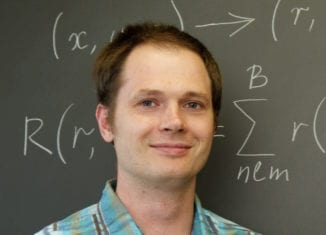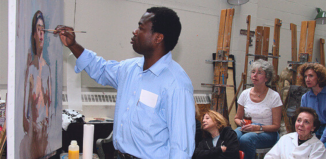SBU’s Kozakov designs program that might speed vaccine design
A high five becomes a natural celebration after a home run because the hitter and the celebratory teammate are standing on their feet and are looking directly at each other. What if gravity didn’t keep our feet on the ground and our heads in the air? We might slap a hand into a foot or a foot into an elbow, sharing a nonverbal exchange with a different meaning.
Proteins inside our bodies don’t have the same gravitational and physical limits. They can and do come together in a soup of cytoplasm, blood, plasma and other mediums. Some of the time, those exchanges, like the high fives, communicate a message in the ordinary course of life. In other circumstances, however, those protein-protein interactions can lead to diseases like cancer.
Researchers around the world have studied these interactions using a variety of tools, trying to combat signals that contribute to damaging and life-threatening conditions.
Dima Kozakov, assistant professor in the Department of Applied Mathematics and Statistics and faculty member of the Laufer Center for Physical and Quantitative Biology at Stony Brook University, has spent several years creating a general way to model the mechanical details of how two proteins interact. This tool could become useful for researchers who are studying problematic interactions.
Leading an international team of scientists, Kozakov, who is also a faculty member at the Institute for Advanced Computational Science at SBU, created a new algorithm to model protein interactions. This algorithm accelerated how to model particular protein-protein interactions to identify harmful couplings. Kozakov and his colleagues recently published their findings in the prestigious journal, Proceedings of the National Academy of Sciences.
Applications of this technology include helping to design therapeutic proteins and speeding up vaccine design. If, for example, the interaction of a pair of proteins contributes to disease, scientists may want to design some other protein that is safe for the patient that will interact with one of the proteins. This additional coupling can avoid the more harmful protein connection.
Scientists also sometimes know that two proteins interact, but they don’t know how. Proteins often have large surfaces with many potential connections. Researchers might need to know “how two bodies come together,” Kozakov said. Proteins are flexible three-dimensional objects that consist of molecules. In modeling the interactions, Kozakov can find the three-dimensional way these proteins come together.
Computational modeling is less expensive than running experiments. At this point, the computer system needs as its starting point the three-dimensional structure of the proteins. That, Kozakov said, is much easier than determining the structure of a protein complex.
The next step is to work on methods where scientists don’t need the structure but only the chemical formula, which they can find through the amino acid sequence. Kozakov and his collaborators will use the information on the structure of similar proteins to build the models. “We’re developing a methodology that will work with the models,” Kozakov said. He described his approach as “physics based,” in which he solves a statistical mechanistic problem by using an energy function that can account for different environments.
“In principal, we can modify our energy function to account for different environments,” like changes in pH, temperature or other variables that might affect how two proteins come together. Given the way Kozakov and his colleagues designed the model, it can account for all possible configurations of two almost rigid proteins coming together.
Kozakov is also in discussions with Brookhaven National Laboratory to explore the results of small-angle X-ray scattering. The benefit of this approach is that he doesn’t need proteins in a crystalline structure, which is a requirement of crystallography. While small-angle X-ray scattering provides less information than crystallography, Kozakov said he and his colleagues can develop it in combination with other techniques where it would be equivalent.
Kozakov has been developing models since 2007 or 2008 to understand these interactions. The project in his recent paper took three years to finish. The program takes 10 to 15 minutes to run on a personal computer. Before, this kind of effort required a supercomputer.
Kozakov believes there could be other applications of this technology, where scientists could model candidate protein drugs in real time to see how the drug interacts with the protein of interest. The first version of the program came out about a year and a half ago and it took the intervening time to perfect it, he said.
Born in Eastern Europe in a region that used to be part of the Soviet Union but is now on the western border of the Ukraine, Kozakov lives in Stony Brook with his wife Olga Kozakova. The couple has a six-year old son, Platon. Kozakov’s grandparents were scientists: his grandfather, Mikhail, was a university professor and his grandmother, Nina, worked at the university. He grew up surrounded by books on physics. He “had fun, digging into antiquities books” and thought the science presented an “inspiring environment.”
As for his work, Kozakov has a big picture view of his efforts. “I want to make something useful to the community and to the world,” he said. “I want to do what I can to help.”







